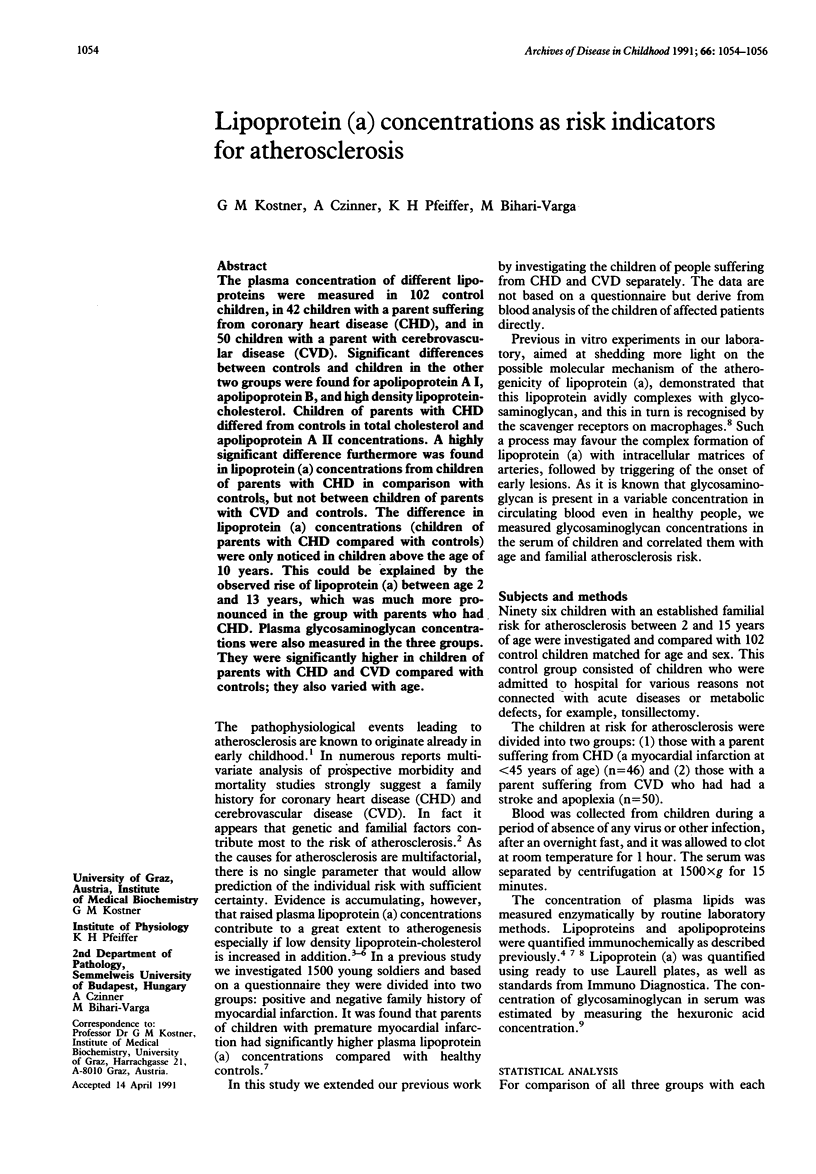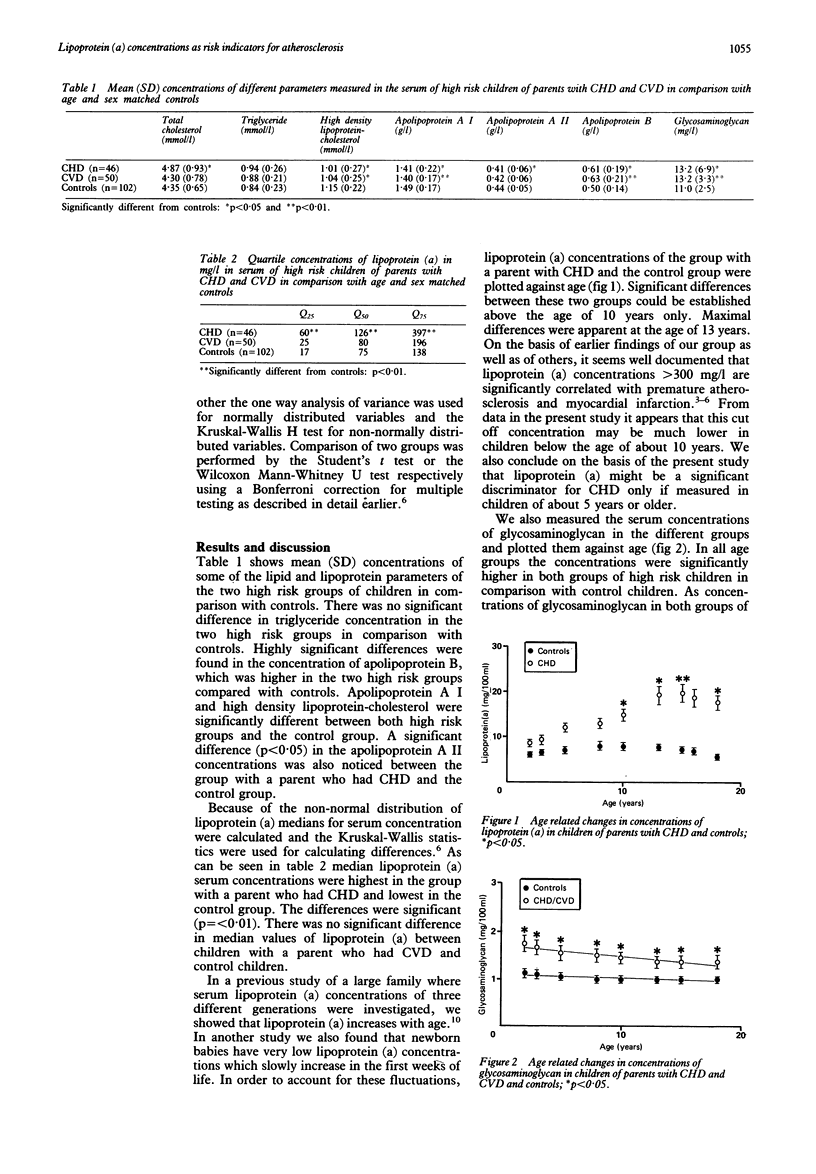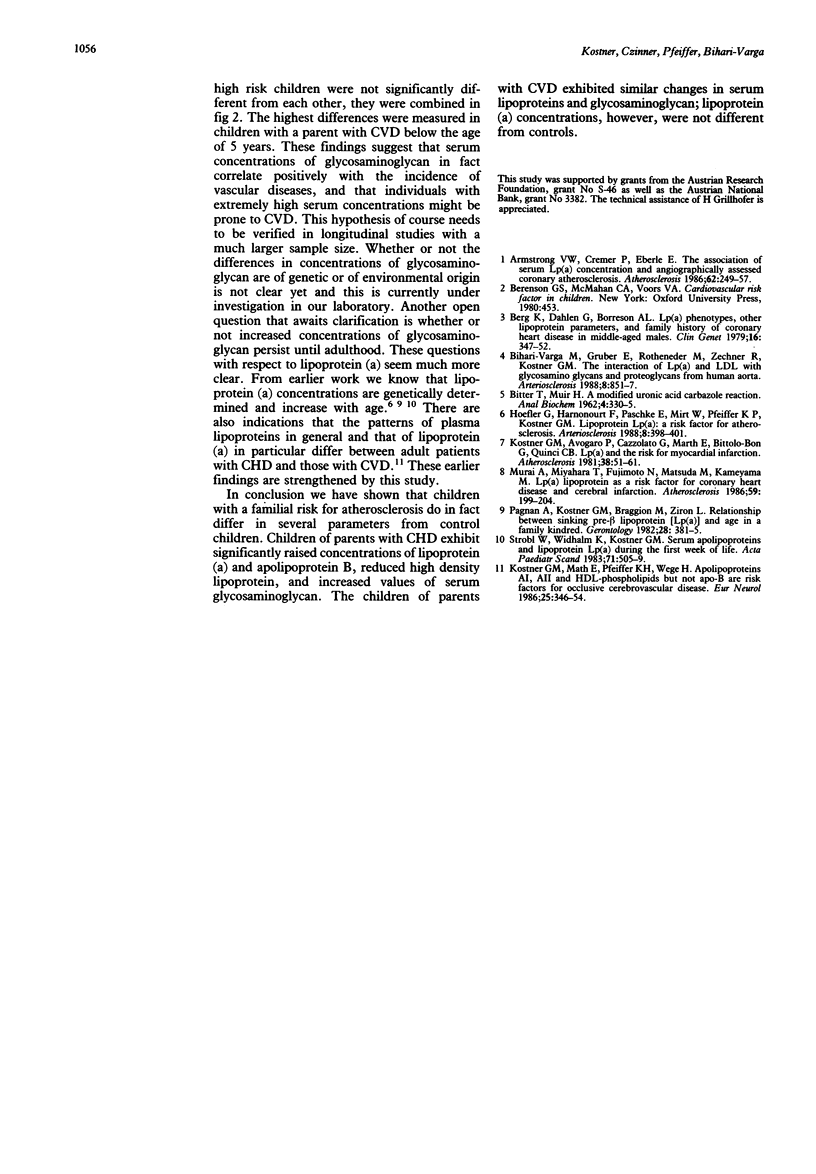Abstract
The plasma concentration of different lipoproteins were measured in 102 control children, in 42 children with a parent suffering from coronary heart disease (CHD), and in 50 children with a parent with cerebrovascular disease (CVD). Significant differences between controls and children in the other two groups were found for apolipoprotein A I, apolipoprotein B, and high density lipoprotein-cholesterol. Children of parents with CHD differed from controls in total cholesterol and apolipoprotein A II concentrations. A highly significant difference furthermore was found in lipoprotein (a) concentrations from children of parents with CHD in comparison with controls, but not between children of parents with CVD and controls. The difference in lipoprotein (a) concentrations (children of parents with CHD compared with controls) were only noticed in children above the age of 10 years. This could be explained by the observed rise of lipoprotein (a) between age 2 and 13 years, which was much more pronounced in the group with parents who had CHD. Plasma glycosaminoglycan concentrations were also measured in the three groups. They were significantly higher in children of parents with CHD and CVD compared with controls; they also varied with age.
Full text
PDF


Selected References
These references are in PubMed. This may not be the complete list of references from this article.
- Armstrong V. W., Cremer P., Eberle E., Manke A., Schulze F., Wieland H., Kreuzer H., Seidel D. The association between serum Lp(a) concentrations and angiographically assessed coronary atherosclerosis. Dependence on serum LDL levels. Atherosclerosis. 1986 Dec;62(3):249–257. doi: 10.1016/0021-9150(86)90099-7. [DOI] [PubMed] [Google Scholar]
- BITTER T., MUIR H. M. A modified uronic acid carbazole reaction. Anal Biochem. 1962 Oct;4:330–334. doi: 10.1016/0003-2697(62)90095-7. [DOI] [PubMed] [Google Scholar]
- Berg K., Dahlén G., Børresen A. L. Lp(a) phenotypes, other lipoprotein parameters, and a family history of coronary heart disease in middle-aged males. Clin Genet. 1979 Nov;16(5):347–352. doi: 10.1111/j.1399-0004.1979.tb01014.x. [DOI] [PubMed] [Google Scholar]
- Bihari-Varga M., Gruber E., Rotheneder M., Zechner R., Kostner G. M. Interaction of lipoprotein Lp(a) and low density lipoprotein with glycosaminoglycans from human aorta. Arteriosclerosis. 1988 Nov-Dec;8(6):851–857. doi: 10.1161/01.atv.8.6.851. [DOI] [PubMed] [Google Scholar]
- Hoefler G., Harnoncourt F., Paschke E., Mirtl W., Pfeiffer K. H., Kostner G. M. Lipoprotein Lp(a). A risk factor for myocardial infarction. Arteriosclerosis. 1988 Jul-Aug;8(4):398–401. doi: 10.1161/01.atv.8.4.398. [DOI] [PubMed] [Google Scholar]
- Kostner G. M., Avogaro P., Cazzolato G., Marth E., Bittolo-Bon G., Qunici G. B. Lipoprotein Lp(a) and the risk for myocardial infarction. Atherosclerosis. 1981 Jan-Feb;38(1-2):51–61. doi: 10.1016/0021-9150(81)90103-9. [DOI] [PubMed] [Google Scholar]
- Kostner G. M., Marth E., Pfeiffer K. P., Wege H. Apolipoproteins AI, AII and HDL phospholipids but not APO-B are risk indicators for occlusive cerebrovascular disease. Eur Neurol. 1986;25(5):346–354. doi: 10.1159/000116033. [DOI] [PubMed] [Google Scholar]
- Murai A., Miyahara T., Fujimoto N., Matsuda M., Kameyama M. Lp(a) lipoprotein as a risk factor for coronary heart disease and cerebral infarction. Atherosclerosis. 1986 Feb;59(2):199–204. doi: 10.1016/0021-9150(86)90048-1. [DOI] [PubMed] [Google Scholar]
- Pagnan A., Kostner G., Braggion M., Ziron L. Relationship between 'sinking pre-beta-lipoprotein' (Lp(a) lipoprotein) and age in a family kindred. Gerontology. 1982 Nov-Dec;28(6):381–385. doi: 10.1159/000212560. [DOI] [PubMed] [Google Scholar]
- Strobl W., Widhalm K., Kostner G., Pollak A. Serum apolipoproteins and lipoprotein (a) during the first week of life. Acta Paediatr Scand. 1983 Jul;72(4):505–509. doi: 10.1111/j.1651-2227.1983.tb09761.x. [DOI] [PubMed] [Google Scholar]


